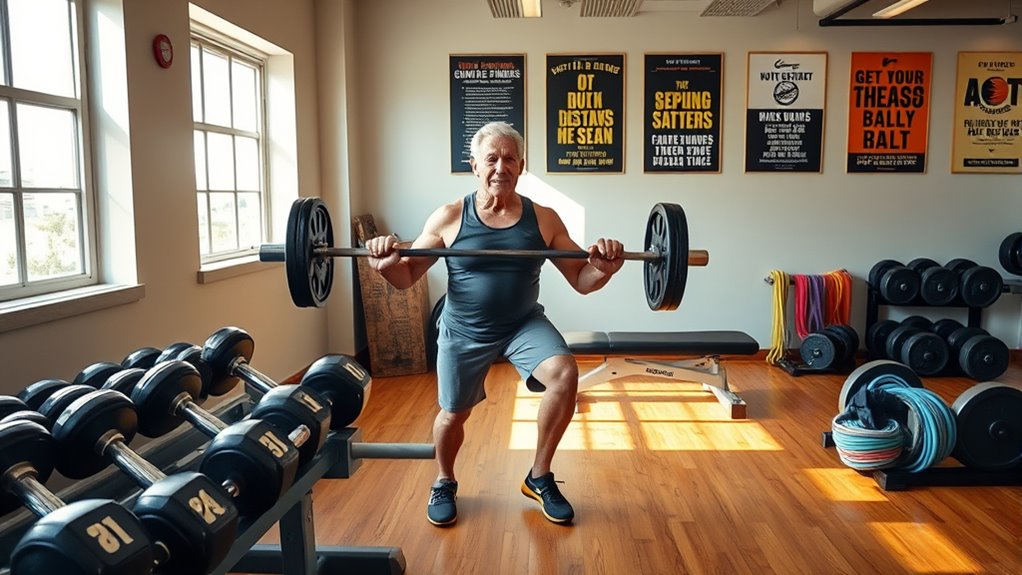Weight lifting is essential for you as a senior looking to stay strong and active. It helps combat muscle loss, improve balance, and enhance bone strength, reducing your risk of falls. Start with light weights, focus on proper form, and aim for two to three sessions a week. Don’t forget to incorporate hydration and nutrition for peak health. You’ll discover more tips on creating effective routines and addressing common concerns to boost your confidence in strength training.
Key Takeaways
- Weight lifting combats muscle loss, improves balance, and reduces fall risk, essential for maintaining independence in seniors.
- Start with lighter weights and focus on proper form to prevent injuries and enhance effectiveness during workouts.
- Incorporate core-strengthening exercises to improve stability and support overall strength training efforts.
- Ensure adequate hydration and protein intake to optimize muscle recovery and growth after workouts.
- Consult a physician before starting a routine, and consider seeking guidance from a fitness professional for safe techniques.
The Importance of Weight Lifting for Seniors

As you age, maintaining your strength and mobility becomes increasingly important, and weight lifting is a key tool in achieving that.
Strength training for seniors helps combat muscle loss, which begins around age 30 and accelerates in your 50s and 60s. By engaging in regular weight lifting, you can build muscle, improve balance, and reduce the risk of falls—major concerns for seniors. Additionally, a low-carb, high-protein breakfast can support your energy levels and muscle recovery after workouts. Engaging in regular physical activity is essential for enhancing overall health and well-being. Moreover, establishing consistent routines can help you stay motivated and committed to your fitness goals.
Strength training combats age-related muscle loss, enhances balance, and reduces fall risk—essential for seniors’ health and independence.
Furthermore, strength training strengthens bones, helping to combat osteoporosis and maintain functional independence. You’ll also notice increased metabolism and calorie burn, aiding in weight management.
Studies show that seniors who lift weights enjoy enhanced muscle strength, better bone density, and improved overall well-being, leading to a more active and fulfilling lifestyle. Furthermore, regular exercise can improve survival rates in various health conditions, including cancer, emphasizing the importance of maintaining an active lifestyle as you age.
Embrace the power of weight lifting!
Getting Started With Weightlifting

Starting weightlifting can seem intimidating, but with the right approach, it’s a rewarding journey. Before you jump in, consult your physician to confirm you’re ready for strength training. Aim to establish a routine with 2 to 3 sessions per week, incorporating 6 to 9 strengthening exercises targeting major muscle groups. Start with 6 to 10 repetitions, focusing on one or two sets, and gradually increase as you build strength. Remember to lift weights slowly, counting to four while lifting and lowering to maximize effectiveness. Maintaining hydration is crucial as it aids in optimal muscle function during workouts. Additionally, necessary cookies support secure and functional website operations, ensuring you can access helpful resources online. Staying active through regular exercise can significantly reduce the risk of Tesla fire incidents related to battery damage in electric vehicles. Engaging in strength training also promotes overall health by enhancing bone density and muscle mass.
| Benefits of Weightlifting | Tips for Getting Started |
|---|---|
| Build strength | Consult a physician |
| Stay active | Start with lighter weights |
| Improve overall health | Create a routine |
Embrace this journey to a stronger you!
Weightlifting Techniques and Tips

Once you’ve established a routine with weightlifting, honing in on proper techniques becomes vital for maximizing benefits and minimizing injury risk.
Start by lifting weights slowly; aim for about four seconds to lift and lower the weight. This helps guarantee proper form and protects you from injury.
Begin with lighter weights, usually between 3 to 5 pounds, and gradually increase as your strength improves. Research indicates that emotional stability can enhance physical training outcomes, making it essential to manage stress levels during workouts. Incorporating structured testing processes in your training can help you track your progress effectively. Additionally, developing strong communication skills with workout partners can enhance motivation and accountability.
Focus on engaging the correct muscles during lifts to avoid compensation from other groups. Tighten your abdominal muscles for stability and to shield your back from stress.
Incorporate core-strengthening exercises into your training; they not only support weightlifting but also enhance balance and stability, essential for daily activities. Additionally, understanding the importance of proper form can significantly reduce the risk of injury while lifting.
Special Considerations for Osteoporosis

If you have osteoporosis or are at risk, incorporating strength training into your routine can be a game-changer for your bone health. Focus on exercises targeting your hips and back, as these areas are essential for preventing further bone loss and promoting new bone growth. Starting strength training early can help combat bone loss and improve your overall health considerably. Additionally, proper emergency preparedness can ensure that you have the resources and support needed in case of unforeseen challenges. It’s important to follow safe lifting practices to minimize injury risk during workouts. Consider seeking guidance from a fitness professional to guarantee you’re using the correct form and techniques. Furthermore, incorporating inflation-protected annuities into your financial planning can help secure your long-term health and wellness. Additionally, maintaining indoor air quality through proper ventilation and humidity control can support your overall well-being while exercising. Regular veterinary check-ups are crucial for older adults with pets to ensure that all health aspects are monitored and managed effectively.
Benefits of Consistent Weightlifting

While many might think of weightlifting as just a young person’s pursuit, consistent strength training offers a multitude of benefits for seniors.
Here are some key advantages to evaluate:
- Increased Metabolism: Weightlifting helps you burn calories, both during and after your workouts, aiding in weight management. Additionally, regular exercise can enhance your overall emotional well-being, making it easier to stay committed to a fitness routine. Engaging in physical activities like weightlifting can also support overall health outcomes, contributing to a better quality of life.
- Improved Muscle Strength: Regular strength training boosts muscle strength and balance, reducing the risk of falls and injuries.
- Enhanced Bone Density: Weightlifting combats osteoporosis, lowering the chances of fractures as you age.
- Better Mental Health: Engaging in consistent weightlifting can elevate self-esteem and reduce anxiety and depression.
- Regular outings promote good behavior and confidence, paralleling the benefits of socialization in dog training.
Nutrition for Strength and Health

To maximize your strength training results, focusing on a balanced diet is key. This means ensuring you get enough protein, vitamins, and minerals to support muscle growth and recovery. Additionally, adopting integrated pest management can help ensure that the food you consume is grown without harmful chemicals, which supports overall health. Don’t forget the importance of hydration; staying well-hydrated helps you perform better and recover faster. Additionally, incorporating celery juice powder into your diet can provide essential nutrients that support overall health and hydration. To further enhance your wellness, consider using essential oils like lavender for relaxation and stress relief, which can positively impact your training recovery. Including baked kale in your meals can also provide vital nutrients and antioxidants that support muscle function and overall health.
Balanced Diet Essentials
A well-rounded diet is your foundation for strength and health as you commence on a weight-lifting journey.
To maximize your results, focus on these balanced diet essentials:
- Protein Intake: Aim for 1.2 to 2.0 grams of protein per kilogram of body weight to support muscle growth and recovery. Coffee’s health benefits can also provide an extra boost to your performance. Additionally, a balanced diet is crucial for optimal energy levels during workouts.
- Calcium and Vitamin D: Make sure you get about 1,200 mg of calcium and 800 to 1,000 IU of vitamin D daily to maintain bone density and prevent osteoporosis.
- Omega-3 Fatty Acids: Include fatty fish and flaxseeds to reduce inflammation and enhance muscle protein synthesis.
- Hydration: Drink at least 8 cups of water daily to support your performance and recovery during strength training.
Additionally, consider the importance of protein intake recommendations, as they play a crucial role in optimizing muscle health.
Consult a registered dietitian to tailor your nutritional needs to your fitness goals.
Hydration and Recovery Importance
Staying properly hydrated is essential for seniors engaging in weight lifting, as it directly impacts your performance and recovery. Mild dehydration can lead to decreased strength and increased fatigue, making it imperative to drink water before, during, and after your workouts.
Proper hydration supports your body’s ability to absorb nutrients, which is fundamental for muscle repair and overall recovery. Additionally, improving indoor air quality can further enhance your overall health and recovery process.
Alongside hydration, a balanced diet rich in protein enhances muscle recovery. Aim for 1.2 to 2.0 grams of protein per kilogram of body weight daily to support your strength training.
Don’t forget to incorporate foods high in electrolytes, like bananas and leafy greens. These foods not only aid hydration but also replenish essential nutrients lost during your workouts, ensuring you stay strong and healthy.
Essential Equipment for Weightlifting

When you start weightlifting, having the right equipment can make all the difference.
Basic weights, resistance gear, and essential safety items are key to a safe and effective workout.
Whether you choose to set up a home gym or head to a fitness center, knowing what to use will help you achieve your strength goals.
Basic Weights and Resistance
Whether you’re just beginning your weightlifting journey or looking to enhance your routine, having the right equipment is essential for success and safety.
Here are some basic weights and resistance tools to evaluate:
- Dumbbells: Start with light weights, typically ranging from 3 to 10 pounds, for safe strength training.
- Resistance Bands: These come in various thicknesses, allowing you to adjust resistance as you build strength.
- Stability Balls: Great for enhancing core strength and balance, they offer a supportive surface for safer exercises.
- Sturdy Chair or Bench: Use this for seated exercises like leg lifts or overhead presses, ensuring added stability.
With these tools, you can confidently initiate your weightlifting journey and stay strong!
Essential Safety Gear
Proper safety gear is essential for anyone diving into weightlifting.
Start with supportive footwear that offers good arch support to prevent slips and falls during your workouts.
Weightlifting gloves are a must; they enhance your grip on weights and protect your hands from calluses and blisters.
To stabilize your lower back during heavy lifts, invest in a weightlifting belt, which provides vital support and reduces injury risks.
Resistance bands should also be part of your gear; they allow for controlled movements and help you gradually increase strength without the dangers of heavier weights.
Finally, consider using foam mats or padded flooring for added cushioning, reducing the risk of injury from falls or dropped weights.
Stay safe and lift strong!
Home vs. Gym Equipment
Deciding between home and gym equipment for weightlifting can considerably impact your fitness journey. Both options have their benefits, and you can choose what suits you best. Here’s a quick comparison:
- Home Workouts: You can use dumbbells, resistance bands, and stability balls to engage in effective strength training without a gym membership.
- Resistance Bands: These offer a versatile, portable solution, allowing you to adjust resistance based on your strength and comfort.
- Stability Balls: Great for enhancing core stability and balance, they’re perfect for home weightlifting.
- Gym Equipment: Free weights and machines provide structured support, ensuring safety and guidance during your workouts.
Whichever you choose, remember to prioritize safety with proper footwear and a secure environment to prevent slips and falls.
Creating a Personalized Weightlifting Routine

Creating a personalized weightlifting routine starts with identifying your specific fitness goals. Whether you want to increase strength for daily activities or improve balance, these goals will guide your approach.
Assess your current fitness level to determine which exercises and intensities suit you best. Aim for at least two to three weightlifting sessions per week, incorporating 6 to 9 different exercises that target major muscle groups.
Begin with lighter weights (3 to 5 lbs.) and focus on proper form to minimize injury risks. As you progress, gradually increase resistance and intensity.
Overcoming Common Misconceptions About Weightlifting

As you commence your weightlifting journey, it’s important to address some common misconceptions that might hold you back.
Overcoming common misconceptions can boost your confidence and awareness:
- Weightlifting is for the young: Research shows strength training helps build muscle mass and health at any age—it’s never too late to start!
- You’ll get bulky: Women generally lack the testosterone needed to gain significant muscle mass, so don’t worry about bulking up.
- It causes injuries: With proper technique and guidance, weightlifting can reduce the risk of falls and enhance bone density.
- You need expensive equipment: Effective weightlifting can be done at home with minimal equipment like resistance bands or light dumbbells.
Embrace these truths and start your strength training journey!
Frequently Asked Questions
What Is the Best Weight Lifting Routine for Seniors?
To create the best weight lifting routine for seniors, focus on 6 to 9 exercises that target major muscle groups.
Aim for 2 to 3 sessions a week, starting with lighter weights around 3 to 5 lbs. Perform 6 to 10 repetitions for 1 or 2 sets, gradually increasing the weight as you build strength.
Incorporate bodyweight squats, step-ups, and lunges to enhance lower body strength, ensuring you maintain proper lifting techniques to avoid injury.
How Many Times a Week Should a 70 Year Old Lift Weights?
You might feel like age limits your strength, but lifting weights can prove otherwise.
Aim to lift weights two to three times a week. Each session should include exercises that target major muscle groups, helping you build balance and muscle mass.
Start with one or two sets of 6 to 10 repetitions, and as you grow stronger, increase the intensity.
What Is the 6 12 25 Rule?
The 6 12 25 Rule is a strength training guideline designed to enhance your workout efficiency.
You perform 6 sets of 12 repetitions with a weight that challenges your muscles but still allows you to maintain proper form. This approach helps you build muscle endurance and encourages growth without risking injury.
How Can a 70 Year Old Get Stronger?
Getting stronger at 70 is like planting a garden—you need the right tools and care.
Start strength training 2 to 3 times a week, focusing on major muscle groups. Use lighter weights or resistance bands and gradually increase as you build strength.
Incorporate balance exercises, like squats, to prevent falls.
Don’t forget nutrition; eat enough protein, calcium, and vitamin D.
Consulting a healthcare professional can guarantee your program is safe and effective.
Conclusion
Embrace the strength of weight lifting and feel the invigorating rush as you sculpt your body and boost your energy. Picture yourself confidently lifting weights, each rep igniting a spark of energy and resilience. As you forge your personalized routine, you’re not just building muscle; you’re crafting a lifestyle filled with health and empowerment. So, grab those weights, and let the journey transform you into the strongest version of yourself, ready to take on life’s adventures with vigor and joy.









